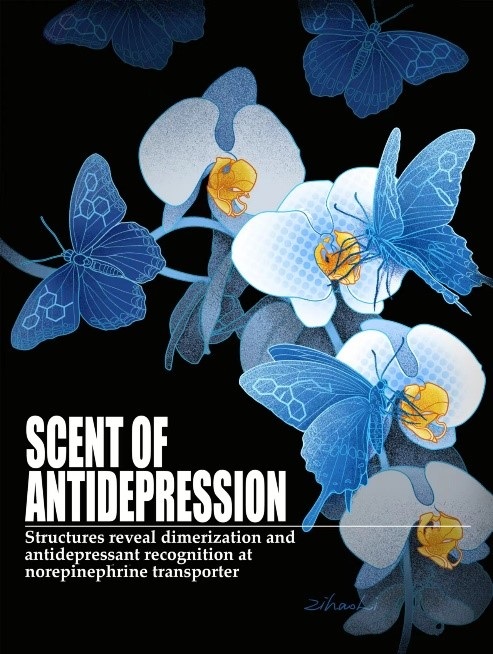Studies Decoding Dimerization and Antidepressant Recognition at Noradrenaline Transporter
Noradrenaline transporter, also known as the norepinephrine transporter (NET), is a member of the monoamine transporters (MATs) family, which also includes serotonin transporter (SERT) and dopamine transporter (DAT). These transporters collectively regulate neurotransmitter concentrations at synapses and maintain neurotransmitter balance in the body. MATs are primary targets for psychostimulants and antidepressants, and abnormal NET function is closely linked to neuropsychiatric disorders such as attention deficit hyperactivity disorder (ADHD).
The function of MATs is regulated by cholesterol and lipid-mediated oligomerization. Early studies indicated that both NET and SERT are associated with cholesterol-rich regions in brain tissue and transfected cell lines. Phosphatidylinositol 4,5-bisphosphate (PIP2) promotes NET dimerization and regulates substrate efflux. However, current limited structural information has hindered a deep understanding of precise binding modes of NET with substrates and antidepressants, the mechanisms of selective recognition of antidepressants by the three MAT subtypes, and precise mechanisms by which cholesterol and lipids regulate NET function and its oligomerization process.
In a study published in Nature on May 15, a research team led by Eric H. Xu and Dehua Yang from Shanghai Institute of Materia Medica (SIMM) of the Chinese Academy of Sciences, and Yi Jiang from the Lingang Laboratory, used single-particle cryo-electron microscopy to obtain eight high-resolution structures of the human NET homodimer. These structures include the occluded conformation bound with substrate norepinephrine (NE), the apo state with no substrate bound, and the outward-open conformations bound with six antidepressants (nisoxetine, amitriptyline, maprotiline, nomifensine, tomoxetine, and nefopam), with resolutions ranging from 2.9 to 3.4 angstrom.
This study presents the first high-resolution structures of full-length wild-type human NET, revealing several significant findings. First, NET forms a homodimer mediated by cholesterol and lipids at the interface, representing a novel mechanism of transporter dimerization. Second, it reveals how the native substrate norepinephrine binds in the central pocket of NET. Third, structures with six different antidepressants illustrate overlapping but distinct binding modes, conferring subtype selectivity over other monoamine transporters.
By significantly advancing the understanding of NET's structure, regulation, and inhibition, these findings will aid structure-based drug design efforts toward improved antidepressants and therapies for neuropsychiatric diseases. The revelations regarding the unique NET homodimer interface and cholesterol-dependent regulation are of broad interest to the membrane protein and transporter fields, and provide a clue for the "lipid raft" model of cell membrane.

Image by Zihao Li
Orchid symbolizes of the NET homodimer, with the white petals representing NET monomers and the yellow lip in the center representing cholesterol and lipid molecules. A butterfly resting on the flower represents selective targeting drugs, which wings adorned with the chemical structures of antidepressants.
DOI: https://doi.org/10.1038/s41586-024-07437-6
JIANG Qingling
Shanghai Institute of Materia Medica, Chinese Academy of Sciences
E-mail: qljiang@stimes.cn




